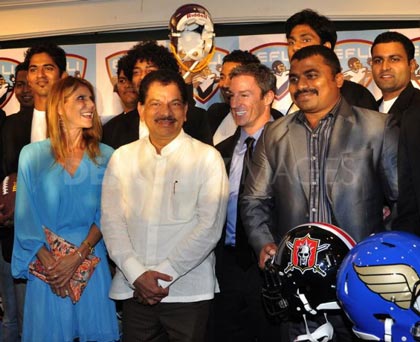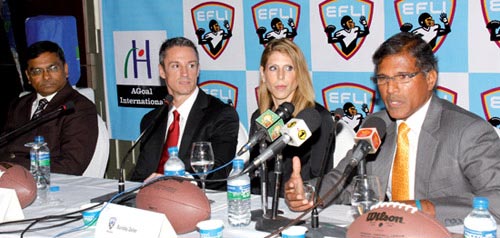Can a Capitalistic Venture Birth a New Sport in a Country?

If American football takes root in India, it would be in no small part due to the messianic zeal of CEO Richard Whelan. (Photo: AP)
Last month our cover story featured the bold initiative of introducing American football as a professional league sport in India. Here, we speak to Richard Whelan, CEO of the Elite Football League of India (EFLI), about the formidable challenges they face in establishing the game in India. In classic American spirit, Whelan exhibits unbridled optimism and belief in the power of capitalism as he shares his vision for the game in India and their extraordinary plans for the execution of a multifaceted plan.
As a young teen in India, I remember one of my captivating joys was in collecting the centerfolds of Sportsweek magazine. From Kapil Dev and Sunil Gavaskar, and yes, even Imran Khan and Dennis Lillee, these pullout centerfolds were a prized collection that I was more than happy to show off.
In the U.S., there is similar excitement surrounding baseball cards, albeit the collectible value of these far dwarfs the worth of any cricket paraphernalia. The point here is not to get sidetracked by comparing the two, but to appreciate the fact that for a sport to be popular and loved in a country, it has to have roots, cultural significance, collectible paraphernalia, and heroes… heroes who are treated like gods by its tender fans. There must be traditions—whether it is bunking school or office to watch a big game of cricket between India and Pakistan, or the kinship of fans and friends getting together over a Super Bowl Sunday in what is also a national TV event of the year. And of course, there has to be a critical mass of the populace that has to have at least a working knowledge of the rulebook if not an appreciation of its many nuances of style and techniques.
Not a single one of these factors is present when it comes to the game of American football in India. Why then would anyone believe it will take hold there?
Ask this question to Richard Whelan, CEO of EFLI, and you soon realize that the operative question in his mind is exactly the opposite, “Why won’t it work in India?” Viewing the issue from an entirely different perspective, Whelan remarks, “What I am doing is introducing a form of entertainment that is the number one form of entertainment on the planet—it is a product called American football. Indians like American products, whether it is Coca Cola or Pizza Hut. That’s a fact. This isn’t sports. This is America’s top form of entertainment—$40 billion on the pro side, $20 billion on the college side. It’s a product that emerged from the most saturated, sophisticated sports business industry on the planet. It’s not that the NFL pushed it. It emerged on its own accord because it was the most fascinating form of entertainment.”
Reducing a sport simply to a commodity is a fairly contemporary idea if not an entirely novel one. Throughout human history sports have grown in following largely organically, and for the most part they have been native in origin. Where adaptation from one nation to another has happened, as in the case of cricket, it has happened socially and culturally, not commercially. So this whole business of thrusting upon an entire nation a sport that is unknown and seemingly incompatible with its culture, and doing so entirely as a capitalistic venture, is a truly revolutionary undertaking. Will it work, I counter again.

Richard Whelan and Sunday Zeller, the founder of EFLI, along with Maharashtra sports minister Suresh Shetty and some of the EFLI players. (Source: Demotix)
With his impressive market research and his high-voltage enthusiasm, Whelan sounds convincing when he says, “India wasn’t big on sports because there was no money in sports. Now money is starting to come in. The Indian Professional League, IPL (cricket) went from nothing to $3 billion [in a short time]. Yet, relative to American standards a very small percentage of the Indian population—only 3.2 percent—is watching it. In contrast, the viewership for NFL is at 10 percent. So in India the growth potential for a TV sports audience is staggering.”
“On Facebook, the IPL has only 2.5 million fans for 1.2 billion people. That’s it. That is an easy number for us to achieve. When the word spreads, four out of 10 kids in India will want to watch this game of football played on TV. If you ask a thousand American students if they would like to watch cricket, you’d be hard-pressed to find three kids who would want to watch it. But if you ask Indian youngsters if they would want to watch American football, 40 percent are saying, ‘Why wouldn’t we?’ If you ask Indian students, ‘Would you like to know the rules of American football?’ they want to. There’s a real demand, a real curiosity. All you have to do is go promote it.”
Like a true entrepreneur, Whelan appears quite well-informed of the market that he has chosen for his product. All throughout our conversation, he quoted statistics as well as observations that indicated an informed grasp of a changing India. He spoke with familiarity about trends and TV shows, of Bollywood actors and cricketers.
So what about going against cricket, I ask? “India is a cricket-crazed country. But there are opportunities for more products,” Whelan continues with the business analogy. “Our target audience is not those who are 40 years and older. We are targeting young Indians, which is one of the largest market segments around. And it’s an incontrovertible fact that they are looking for alternative sports.” To bolster his point, Whelan points to the success of World Wrestling Federation in India, as a sport that has gained rapid TV audiences there.
Shifting to sports terminology and referring to last year’s first EFLI season in India, he adds, “American sports has always emphasized on building athletes. We know that we have the top four athletes in India. If you take M.S. Dhoni or Tendulkar and put them against our top four and make them run the decathlon: who can run the fastest, who’s the strongest, our athletes will beat the top two cricketers. Guaranteed. They’re faster, they’re quicker, they’re stronger, they have more endurance, better hand-eye coordination. The top athlete is what humans go to see. Even in the Roman Coliseum, the kings went to see the ultimate gladiator, which was defined by attributes—strongest, fastest, quickest, smartest. This game of football is the ultimate gladiator game. People want to see the ultimate athlete. That’s what we’re building. When you look for the top athletes in India, our athletes are going to be right there on page one.”

With Sunday Zeller and Sri Lankan EFLI officers at the launch ceremony. (Source: Sunday Observer, Sri Lanka)
It may be easy to discount this enthusiasm as one man’s wishful thinking. However, judging from what EFLI was actually able to pull off so far, it appears Whelan may be on to something. As he points out, Atul Pande, CEO of Ten Sports, South Asia’s biggest sports content provider, “decided against all odds to take a chance on this product, giving us hundreds of hours of content on primetime.” Referring to the broadcast rights till 2016 for EFLI that Ten Sports acquired, Pande had commented last year, “We are delighted to partner with Elite Football League of India…. We are looking forward for high-decibel games with loads of excitement and passion.”
Right. But where does one start? Forget popularity, even for a functional getting-off-the-grounds, you need players, coaches, and spectators who have a working understanding of the game, if not a passion for it yet. Whelan talks about wanting to create “the most successful sports league in the world.” But that’s a far cry from the daunting task of first creating a demand for his product; a product that requires a learning curve, short of which audiences cannot understand, far less appreciate, the nuances of the plays. Minus such a familiarity, the game simply appears to the uninformed observer as a raw, clumsy, and exasperating clash of big, burly men, interrupted far too often by seeming randomness.
This lack of history, legacy, and knowledge of the game, along with a questionable appetite of Indians for a sport that is eminently injury-prone, makes Whelan’s job akin to selling refrigerators to Eskimos.
If there is a salesman who can do just that, it may well be Whelan. He had already managed last year to raise $8.5 million for this venture, backed by high-profile investors like celebrity coach Mike Ditka, Hollywood actor Mark Wahlberg, and Indian-American NFL player Brandon Chillar.
What was accomplished at the grassroots level in India in the 2012 debut season is also quite impressive. The EFLI had organized orientation programs in major cities of India with the objective of recruiting players, coaches, referees, and others. Despite the odds against the game, these orientations attracted over 4000 players, many of them athletes from other sports such as rugby, kabaddi, and soccer.
Recognizing the need to build the audience from ground up, the EFLI has signed up with one of the largest universities of India. “This university has 200 to 300 affiliated colleges. This is not a joke,” stresses Whelan with pointed enthusiasm. From training Indian sports commentators and coaches to conducting high school championship flag football games, laying the legal infrastructure to selling the franchises, building a brand for each of the teams to addressing the concern of injuries, buying TV time to forging relationships with India’s leading sports-business executives, the multipronged efforts are indeed breathtaking in scope and range.
But will they be enough to make American foot- ball attractive to Indians? After all this is the country where a professional league of hockey, its national sport, only lasted four seasons.
.jpg)
Throughout our interview, Whelan stressed how American football was “the most beautiful thing on TV.” “Green grass, white lines, gladiators, beautiful helmets, shoulder pads…it reminds you of youth, vigor, and beauty.”
That may be the case when seasoned pros, fetching multimillion dollar salaries, are playing on American soil—but it is altogether different when the novice minions of a fledgling sport are learning the plays in live seasons. As per a New York Times article on the EFLI, Amit Paranjape, a software engineer who lived in Dallas for 12 years, and a fan of the Packers and Cowboys, checked out the EFLI leagues games on TV, but soon changed the channels after a few plays. “It was like a bad dream,” he is quoted in the article.
Whelan himself was quoted in the same article as saying, “It’s an absolute joke compared to the NFL.” Why then is he still so gung ho on his import? “Here’s a significant fact about sports viewership. Countrymen like to watch their own athletes compared to those of other countries no matter how good or bad. When India has athletes in the Olympic or Commonwealth Games, they tune in. Every Indian boy will want to watch their own top athlete, not some 300-pound American whose name they don’t even know.”
If American football takes hold in India, it will be in no small part due to the messianic zeal of Whelan. In our game of missionary versus skeptic, I throw a final gauntlet at him: in the land of Gandhis and geeks, a game that involves physical head-on collisions as a matter of routine cannot take hold. That’s when Whelan turns to psychology and prophecy: “Here’s the truth. The American coaches that went out there said [the Indians] are way more aggressive than the American players. They had to peel them back because they were bloodthirsty guys. Here’s why football will work in India: There is a pent up aggression in all males that is ready to be unleashed. The boys are tired of being told to act like girls. They’re looking for heroes. That’s why Hrithik Roshan made it big. That’s why Shahrukh Khan had to go from being a pretty dancing boy to a rock actor. You can see the progression. The boys are becoming men. India is a tiger waiting to be unleashed. Football unleashes the potential masculine aggression that has been subdued for centuries in India. We’re opening the doors for these little boys, children, and men to say, I love it, and find out what it’s like to be a man. We’re tapping into the very soul of India. That’s what’s happening here. That’s why it’s a revolution. That’s why football is going to be the number one sport in the world. EFLI’s guaranteed to be the biggest league in the world. It’s undeniable.”
Enjoyed reading Khabar magazine? Subscribe to Khabar and get a full digital copy of this Indian-American community magazine.
blog comments powered by Disqus










